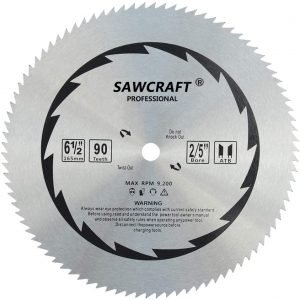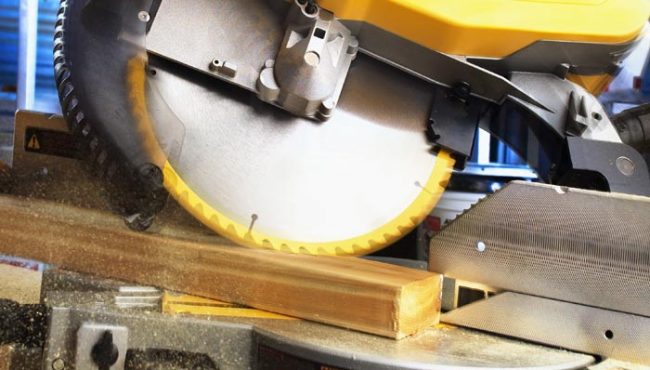Types of Circular Saw Blades & Glossary
Any saw is only just like the blade you add to it. The blade you’re using can often make or break your project. All the adjustable power and speeds in the world won’t allow you too much if you don’t have an appropriate blade. Simply because selecting the correct blade is so important, it is crucial that you gather all the information you can before choosing one.
To help you on this mission, we’ve assembled this complete self-help guide to woodworking circular saw blades. Everything you need to consider is included in this handy guide.
Types of Circular Saw Blades
There are several varieties of woodworking circular found blades out there. Every blade has a various design to make certain cuts and get through specific materials. Because every blade has a distinct purpose, it is vital that you choose a blade designed to do what your project demands. A blade designed for rip slashes should not be used to make crosscuts, for example. It could even be dangerous, though not merely will using the wrong blade result in an unsatisfactory cut. Using the wrong type of blade can cause it to snap while in use, which can be a safety hazard.
Combination Blades

This blade is designed to be as multi-goal as possible. This is often the type of blade included with most saws. It can be used to cut across or parallel to the wood grain. Often, this blade is suitable for house DIYers who need a blade they can use for a variety of diverse projects. However, simply because of its general design, this blade is often not the best choice for any task – just an okay option. It is definitely a jack-of-all-trades but a master-of-nothing.
Crosscutting Blades

This blade is designed to do exactly what the name implies – cut all over the wood grain. They typically have more teeth and a small gullet, which helps them achieve smoother cuts. They are utilized mostly for cutting short-grain wooden while ripping blades are used for long-grain woods.
Dado Cutting blades

A dado blade is designed to cut dados, or grooves, into wooden materials. There are 2 main types of dado blades – loaded blades and wobble blades. Stacked rotor blades consist of two noticed blades and a chipper blade put together. The saw blades cut out the groove along with the chipper removes the waste material and smooths the bottom. A wobble blade is only a circular blade fitted onto an adjustable center. Usually not very effectively, even though this allows you to alter the depth of the minimize.
Fine-Tooth Finish Blades

These blades are designed for more-smooth slashes. They have very small teeth and do not cut quickly. However, the slices they leave behind are extremely smooth and splinter-free.
Hollow Ground Blades

These rotor blades are designed for making extra-smooth slashes on coated boards and extra-great crosscutting. They are specifically designed for cutting protected boards, such as plywood. Because an extremely razor-sharp blade is required to reduce these materials properly, carbide tipped rotor blades are often used.
Paneling Blade

For all your woodworking requires that don’t particularly involve wood, this is basically the blade you need. It is designed to cut by means of laminates, soft plastic materials, paneling, and other not-exactly-wood materials. While this type of blade isn’t usually used to cut wood, it is necessary enough in carpentry projects that we chosen to include it.
Plywood Blades

These cutting blades are designed to cut via plywood, as the brand suggests. Plywood might be a troublesome material to slice, which is why a particular sort of blade is required. These blades have a lot of teeth and are designed to perform basic cuts on plywood, typically.
Ripping Blade

This blade is made with very large teeth that allow it to cut parallel to the wood grain. They are specifically designed to use with long-grain woods, when crosscutting blades must be used with short-grain woods.
Thin Kerf Blade

Lean kerf blades are, simply put, thin. This makes it possible to get more omits of a single component of wood. For this reason, they are often used by pencil producers and other companies who make small, wooden objects. These finer blades can also let an underpowered found work better considering that the available power is focused on a smaller area.

Glossary
Alternate Top Bevel
This is a particular type of tooth that alternates between a right-left and handed-handed bevel. Normally, they are used to make smooth cuts when crosscutting.
Combination Teeth
This type of blade teeth is designed to both crosscut and rip. They can be usually found on combo blades.
Crosscutting
A cut made over the wood in the direction of the wood grain.
Enlargement Slot
A grooved area is cut into the blade to provide built-up heat a place to go. This is usually found on larger sized blades.
Flat Top rated
This type of tooth is commonly used for ripping equally hard and smooth woods.
Gullet
This is actually the part of the blade that may be between the teeth. Besides, just separating the tooth, this area helps with chip removal while you are cutting. Blades that can rip typically have even bigger gullets since they develop bigger chips. Crosscutting blades have small gullets because they generate smaller chips.
Great Alternate Top Bevel
This type of blade tooth is designed for extra-fine crosscutting.
Connect Tooth
This is how the sawtooth is angled in relation to the center of the blade. This controls the feed level for the blade.
Kerf
The “kerf” of your blade is simply how wide it is. A thicker blade lasts longer because you can resharpen it more; there is certainly simply more material to work with. However, slimmer blades are sharper and can cut quicker. They can be a particularly good choice for saws that never produce much potential. But, they lower rougher edges than thicker blades.
Adverse Hook Angle
A blade with a bad hook angle has teeth that hint away from the direction the blade rotates. This causes the feed price to slow down.
Positive Hook Angle
A blade with a beneficial hook angle has teeth that hint towards the direction the blade rotates. This will cause the feed level to speed up.
Shoulder
This is the section of the blade directly behind the teeth. It helps strengthen the teeth which will help prevent the blade from breaking.
Teeth
They are the sharp points of your blade that do the specific cutting. Blades have varying numbers of pearly whites depending on the purpose and design. Fewer, bigger teeth make rougher cuts but reduce faster. Smaller the teeth cut slower but in addition produce a smoother cut.
Zero Degree Connect Angle
This represents saw teeth that happen to be in line with the center of the blade. It lacks a positive or negative impact on the feed price.
FAQ‘s
What kind of noticed blade should I use?
This depends largely on what you’re will be using the blade for. You should first consider the information you’re going to minimize. Not all blades will likely be able to cut all materials. Even carpentry blades are designed to lower different types of wood. All-natural wood is going to need a different blade than plywood, for example.
Following, consider what types of slices you’re going to be making. Are you going to be crosscutting or ripping? Or both? This will give you a good clue in regards to what type of blade you should buy.
Finally, you must also consider whether you’re in the market for a specialized blade or whether it is in your best interest to buy one or two versatile blades. If you’re a homeowner who just occasionally must cut something, a combination blade is probably what you want. Professional woodworkers will likely need to commit to a variety of different blades, however.
The sort of foundation you’re using is likewise important. An underpowered saw works best when equipped with thinner cutting blades, for example. You should also carefully check what dimensions blade your found is designed to use. You may only use blades that match the capacity of your own saw. A 12” blade simply won’t fit on a saw designed for 10” rotor blades.
Are coated cutting blades worth the money?
The main purpose of a covering is to reduce the volume of friction and heat created when cutting. This helps prevent burn marks on the wood. A coated blade may be worth it for you if you’re concerned with how the finished product looks as-is. A coated blade isn’t necessary for the event you don’t care how the finished wood looks or are considering painting over it anyway.
Maybe you would like this

Jerome T has tested home security systems in his own apartment, installed GPS trackers in his own car, and watched her cat, Toki, nap all day through a live nanny cam feed. As an expert reviewer, he believes that firsthand experience is the best way to learn about new products (even if it requires being the guinea pig).And a huge Nascar fan who loves to go camping and enjoys the outdoors.






